Physical Address
304 North Cardinal St.
Dorchester Center, MA 02124
Successful bowel ultrasound is facilitated by use of high-frequency transducers and real-time viewing of the bowel activity. Oral fluid administration and graded compression techniques help displace interfering bowel gas.
Accurate measurement of the pyloric muscle thickness with adequate distention of the stomach with fluid is the key to correct diagnosis of hypertrophic pyloric stenosis. When the pylorus is normal, the duodenum should be examined, as well as the mesenteric vessels.
The diagnosis of ileocolic intussusception can be made with ultrasound with a high degree of accuracy, precluding the need for a diagnostic enema when normal. Transient small bowel intussusceptions are common, have a different appearance on ultrasonography, and do not require treatment or follow-up unless very long or persistent.
Inflammatory conditions of the small and large intestine can be easily evaluated with ultrasound. Specific features such as mucosal or transmural edema, echogenicity, and blood flow assessment with Doppler imaging can help to narrow the range of differential diagnoses and can be used to monitor therapy.
Ultrasound findings of bowel wall thickening and pneumatosis intestinalis can help make the diagnosis of necrotizing enterocolitis when not evident on radiographs. Complex fluid in the abdomen helps to diagnose perforation in infants with a gasless abdomen.
Ultrasound is the procedure of choice for the initial evaluation of the child with acute abdominal pain. Appendicitis can be detected in the majority of children with experience and proper technique. Secondary findings such as absent bowel peristalsis, mesenteric edema, and free or loculated fluid collections can help make the diagnosis of appendicitis, even when the appendix itself is not visible.
Cystic abdominal masses are well seen with ultrasound and may be associated with the gastrointestinal tract. Wall characteristics and presence of internal septations, debris, calcifications, or fat can help to determine the etiology of the mass.
Ultrasound of the pancreas in children is most helpful for identifying peripancreatic fluid collections or pseudocysts resulting from pancreatitis and detecting cystic pancreatic masses.
Sonography has become an important diagnostic imaging modality in the evaluation of the gastrointestinal (GI) tract of children. Ultrasound permits direct visualization of the various mural layers of the GI tract. The ability to observe GI dynamics without exposure to ionizing radiation is an added asset of sonography. Video clips made during scanning can be a valuable resource to view peristalsis and to capture subtle abnormalities in mobile children. Ultrasound is most suitable for portions of the GI tract that are not surrounded by or filled with large amounts of gas. The stomach is best evaluated after allowing the patient to ingest clear fluids. Sugar water works well for infants.
Normal pyloric muscle thickness ≤2 mm
Normal gastric mucosa thickness ≤2-3 mm
Peristalsis through pylorus
Most of the esophagus is inaccessible by sonography because of surrounding aerated lung. Only the subdiaphragmatic portion of the esophagus is usually visible ( Fig. 53.1A ). The gastroesophageal junction can be seen by examining the patient with sagittal images in the supine or right-side-down decubitus position. This technique permits observation of the function of the gastroesophageal junction and can be used to detect gastroesophageal reflux. Reflux is noted when fluid is regurgitated into the retrocardiac portion of the esophagus ( Fig. 53.1B ). Color Doppler sonography may facilitate the detection of gastroesophageal reflux. Hiatal hernias can also be detected with sonography, which may be more sensitive than barium studies for detecting small degrees of herniation ( Fig. 53.2 ). However, the sonographic techniques required are operator dependent and have not gained much popularity. Therefore esophageal abnormalities are usually assessed with other imaging modalities, such as fluoroscopy or endoscopy.
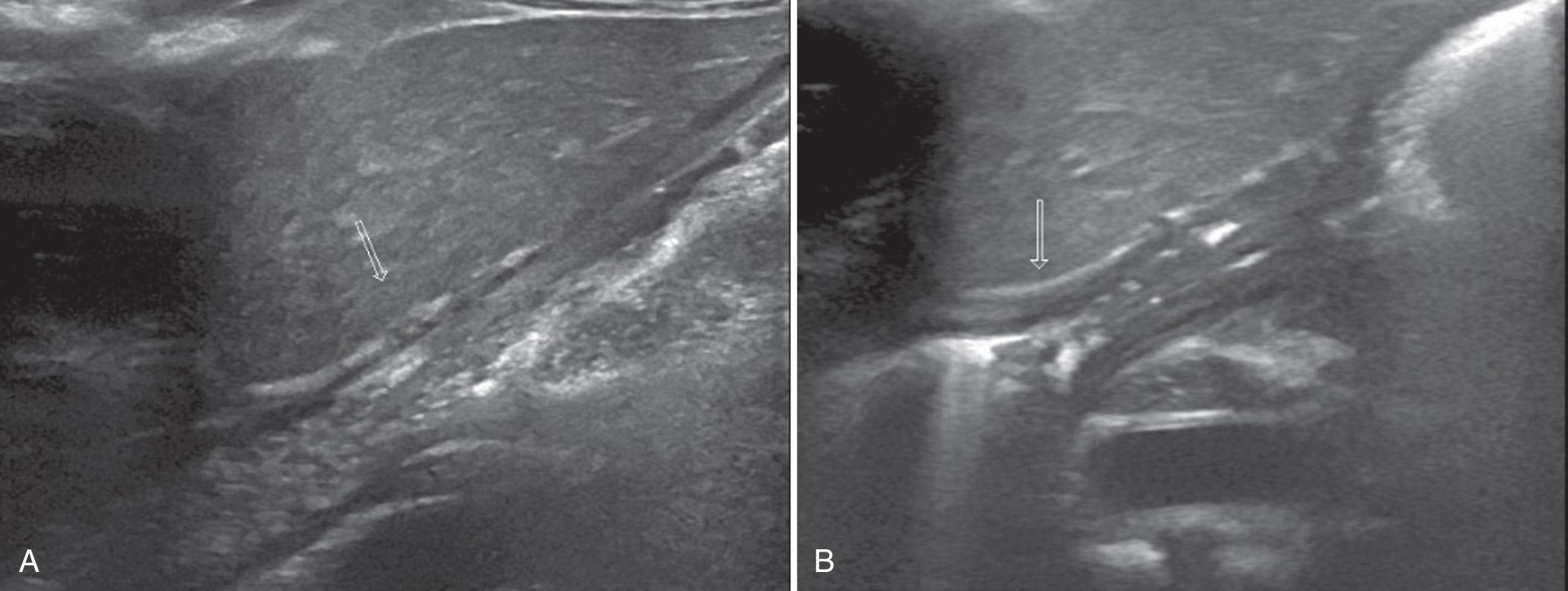
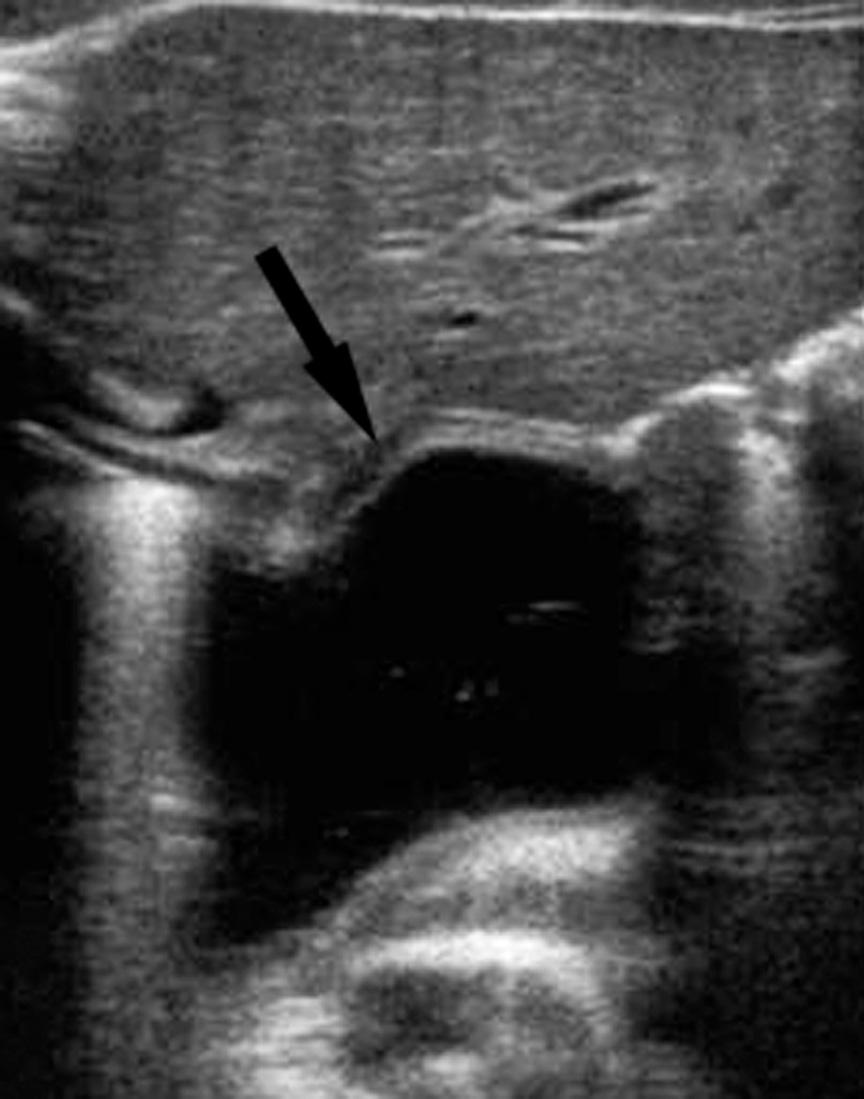
Most abnormalities of the stomach in infants and children involve the gastric antrum and distal third of the stomach. This portion of the stomach is easily evaluated using the liver as an acoustic window. Distending the stomach with clear fluid facilitates evaluation of the mucosal, submucosal, and muscular layers of the stomach ( Fig. 53.3 ). Furthermore, gastric peristalsis and emptying can be evaluated.
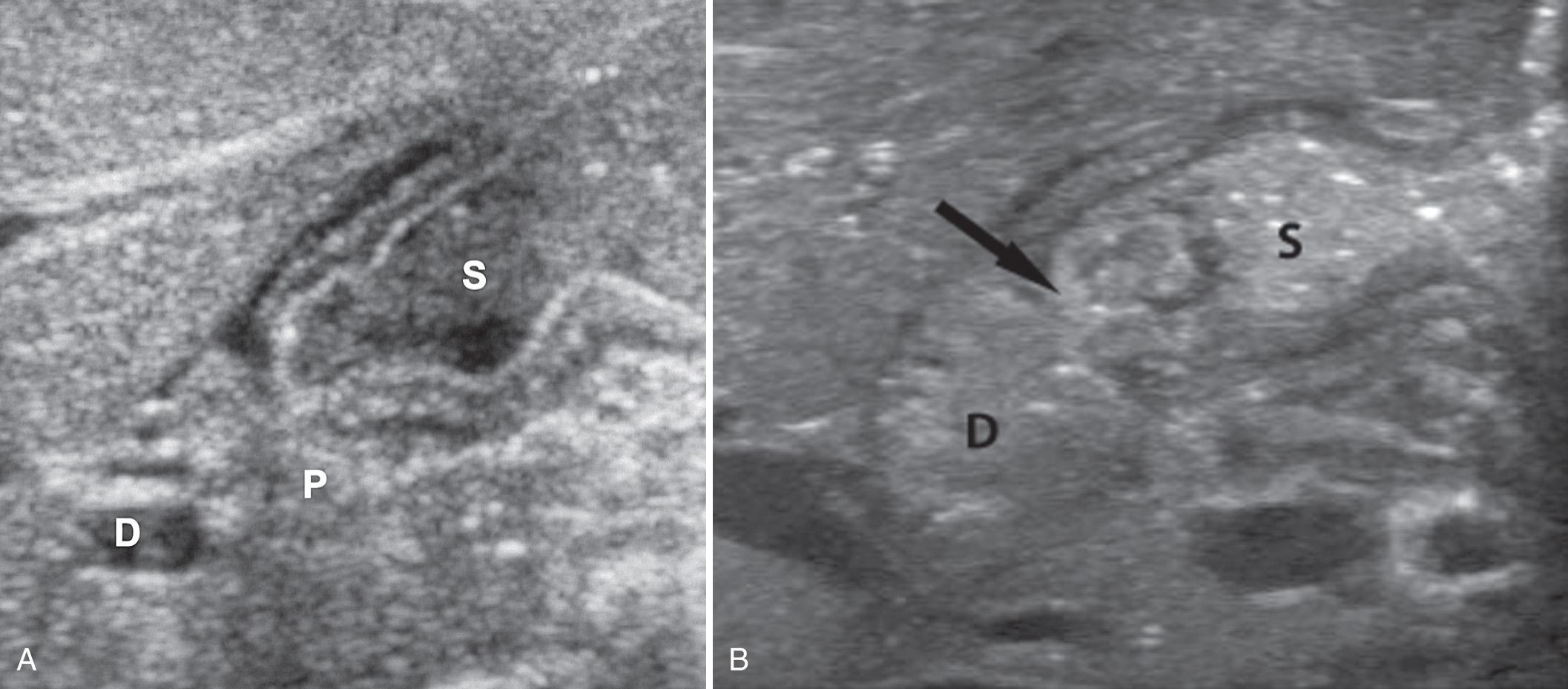
Normal gastric mucosa, including the muscularis mucosae and submucosal layers, measures 2 to 3 mm, whereas the outer circular muscle layer measures between 1 to 2 mm in thickness. These measurements should be obtained with the stomach fully distended with fluid, and the scan should be performed in the midlongitudinal plane of the stomach or, on cross section, proximal to the pyloric canal, measuring the single muscle wall thickness, excluding the mucosa. On cross-sectional imaging, if the image obtained is too close to the contracted pyloric canal, thickening of the pyloric muscle can be suggested erroneously. Similarly, if tangential images are obtained on the longitudinal plane, the muscle may erroneously appear thickened ( Fig. 53.4 ). This same phenomenon is also seen with the echogenic mucosal layer.
Muscle width ≥3 mm
Pyloric canal length ≥1.5 cm
No peristalsis through pylorus
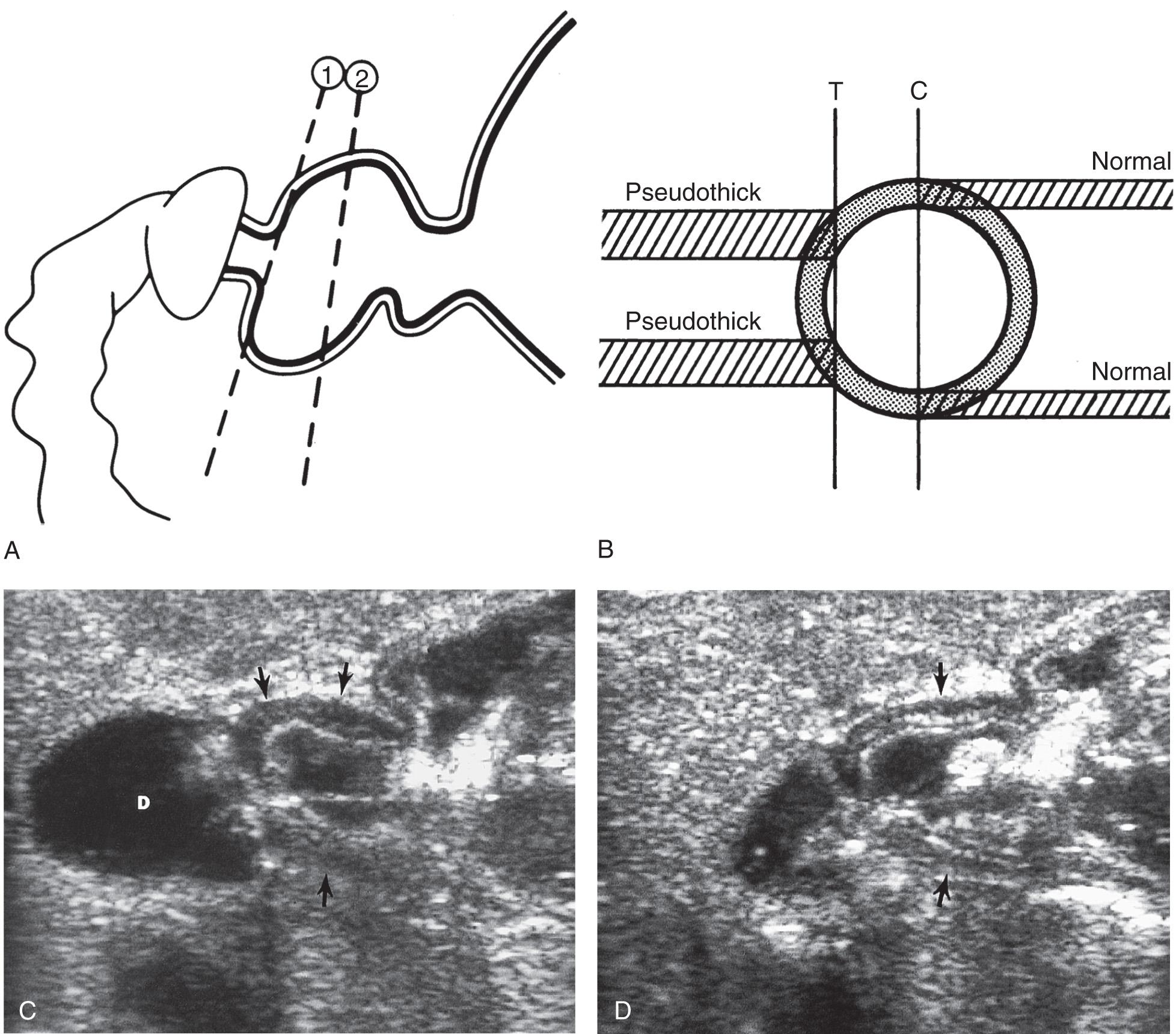
During the past decade, sonography has replaced the radiographic upper GI series for the diagnosis of infantile hypertrophic pyloric stenosis (HPS). Unlike the upper GI series, which demonstrates only the indirect effects of pyloric muscle hypertrophy on the gastric lumen, ultrasound allows direct visualization of the gastric muscle thickening that is the hallmark of the disease. Although a few pitfalls in the sonographic diagnosis of HPS exist, the technique is relatively easily mastered and results in greatly improved accuracy of diagnosis and patient outcome. Indeed, the accuracy approaches 100%, and ultrasound is now the procedure of choice for the detection of pyloric stenosis.
After the initial documentation of the sonographic detection of the hypertrophied pyloric muscle in pyloric stenosis by Teele and Smith, many studies described the characteristic findings of HPS. Increased pyloric muscle thickness and canal length; increased transverse diameter of the pylorus; thickened, redundant mucosa; estimation of the degree of gastric outlet obstruction; and calculation of pyloric muscle volume have all been used to diagnose pyloric stenosis. However, of all the criteria, thickening of the pyloric muscle and elongation of the pyloric canal have emerged as the most consistently useful. The thickness at which the muscle is considered hypertrophied is 3 mm or greater when measuring the hypoechoic single muscle layer transversely. Pyloric canal length of 1.5 cm is considered diagnostic of pyloric stenosis when seen in conjunction with thickened pyloric muscle.
In the classic case of HPS, the thickened muscle mass is seen as a hypoechoic layer just superficial to the more echogenic mucosal layer of the pyloric canal ( Fig. 53.5 ). In cross section, this “olive,” on clinical palpation, resembles a sonolucent “doughnut” medial to the gallbladder and anterior to the right kidney. Often, small amounts of fluid are visible trapped between the thickened echogenic mucosal folds, corresponding to the “string” (elongated canal) and “double tract” (folded mucosa) signs previously described on radiographic upper GI series. In longitudinal section, sonography also permits evaluation of functional alterations at the pylorus. Active gastric peristalsis that ends abruptly at the margin of the hypertrophied muscle, absence of a normal opening of the pylorus, and diminished passage of fluid from the stomach into the duodenum are useful adjunctive findings in pyloric stenosis. Thickened mucosa within the pylorus often accompanies the muscle hypertrophy. Although most often an isolated abnormality, HPS occasionally accompanies other obstructive antropyloric lesions, such as duodenal feeding tubes ( Fig. 53.6 ), eosinophilic gastroenteritis, antral polyps, and idiopathic or prostaglandin-induced foveolar hyperplasia.
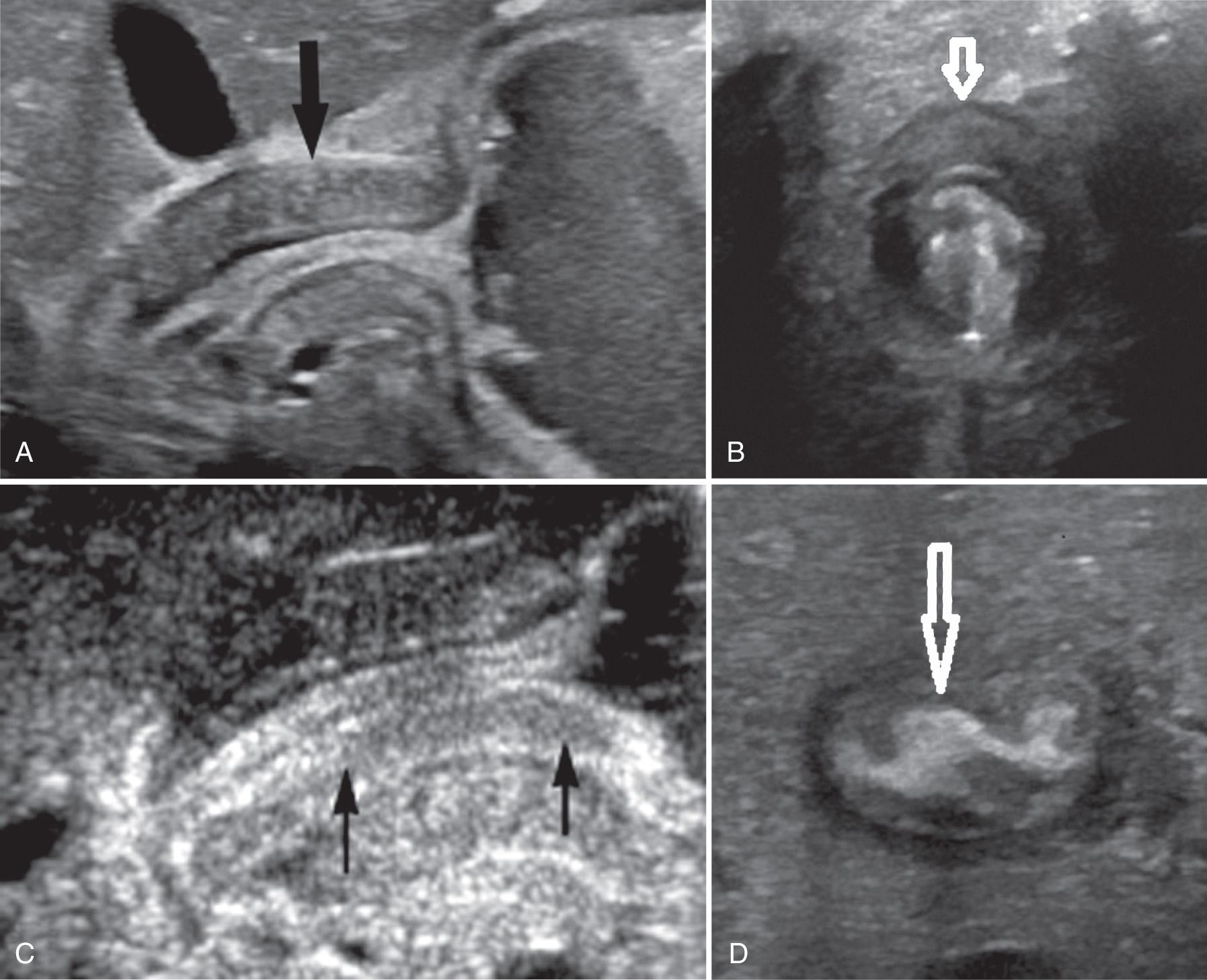
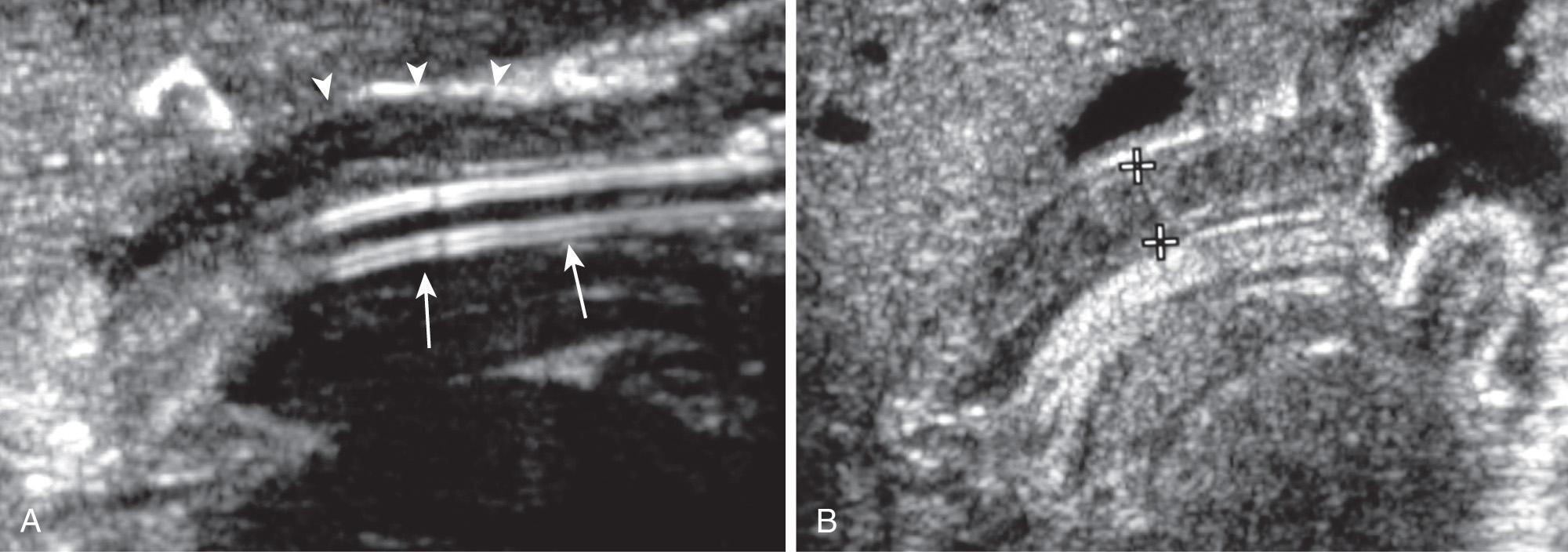
The length of the pyloric channel is typically shorter in premature infants with pyloric stenosis, but normal pyloric measurements for premature infants are not well established. At surgery of premature infants with HPS, the mass is reportedly softer, more pliable, and thinner. Rarely, HPS manifests during the first 14 days of life and can be challenging to diagnose because most consider HPS to occur after 2 weeks of age. These infants are often thought to have severe reflux, and ultrasound criteria for these younger infants are also not established. Those with presentation before the expected age range are more likely to have a positive family history than those with presentation after 2 weeks of age, and more of these infants have been breast fed. The muscle thickness is also decreased relative to the older HPS patient, with some advocating a muscle thickness of greater than or equal to 2.5 mm and channel length of greater than or equal to 14 mm for criteria in these younger patients.
Ultrasound also is very useful for the evaluation of persistent vomiting in the postpyloromyotomy patient. The fluoroscopic upper GI series is of limited value in such cases because it tends to show persistent deformity and narrowing of the canal even in asymptomatic patients. However, sonography can definitively identify persistently thickened muscle, although cautious interpretation in postpyloromyotomy patients is recommended because the pyloric muscle may not reach its normal thickness until 8 months after surgery ( Fig. 53.7 ).
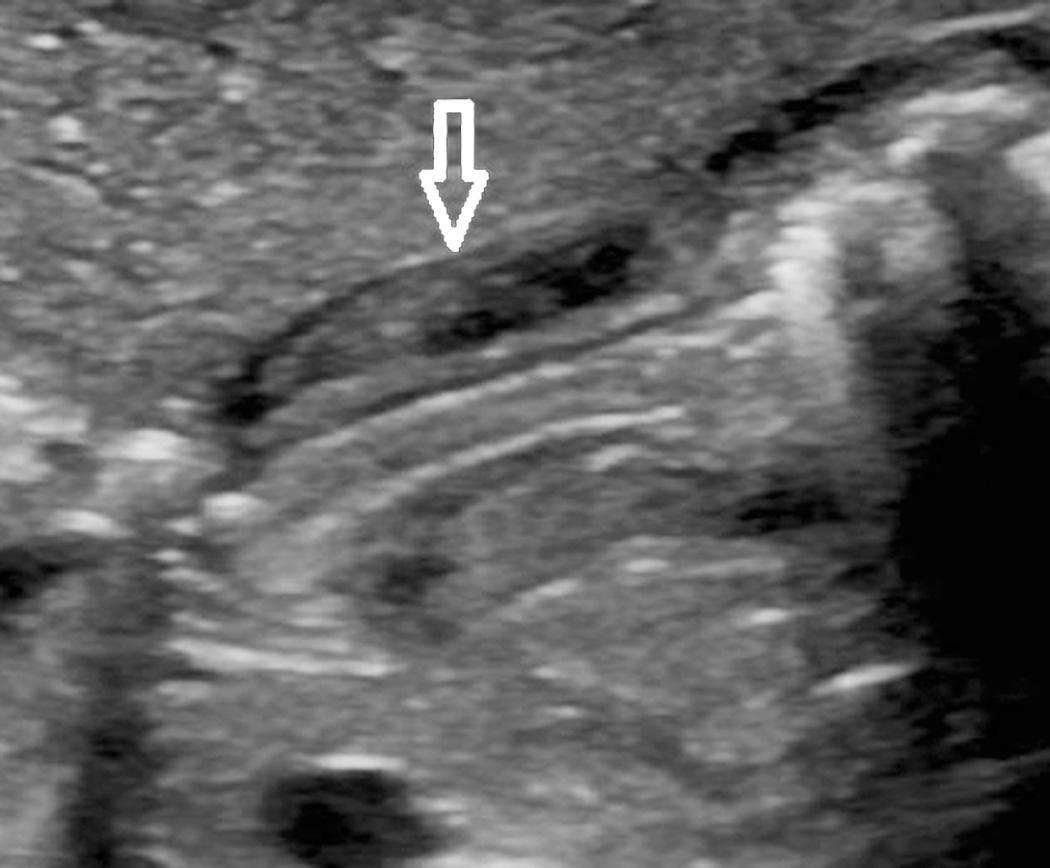
In some vomiting infants, sonography shows a persistently contracted and elongated canal, but the degree of muscular thickening is less than the criterion of 3 mm for surgically correctible HPS. With extended observation, eventually the canal opens and fluid is seen to pass into the duodenum, but the periods of spasm predominate ( Fig. 53.8 ). In the vast majority of cases, there is no thickening of the pyloric muscle or mucosa, and the problem is primarily nonspecific pylorospasm (antral dyskinesia). This condition can accompany milk allergy or other forms of gastritis.
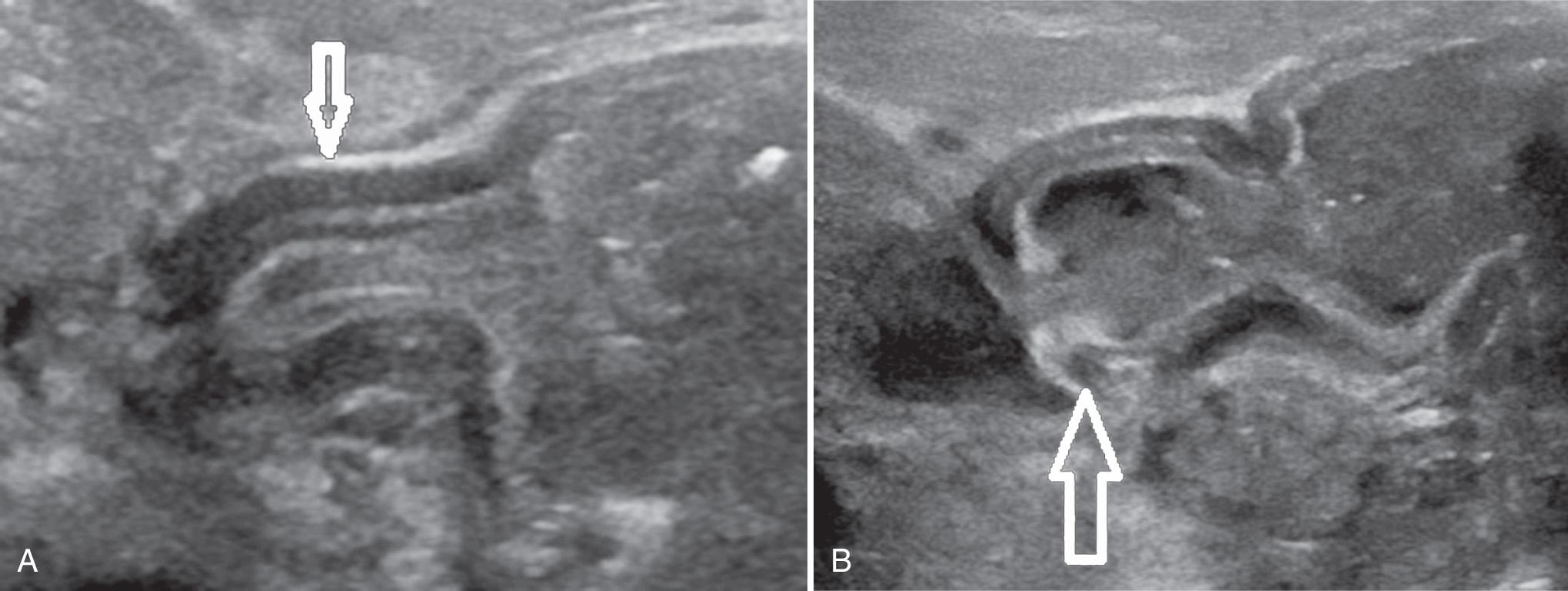
In some cases the pyloric muscle is mildly thickened, measuring 2 to 3 mm. Such patients should be distinguished from those with normal muscle thickness (<2 mm) because in some patients minimal muscle hypertrophy can eventually progress to classic pyloric stenosis. In other infants, minimal muscle thickening will resolve spontaneously, but such patients should be followed closely with ultrasound until the muscle regresses to a normal thickness.
The echogenicity of the pyloric muscle varies according to the angle at which the ultrasound beam crosses the muscle fibers. During sonography of HPS, the hypertrophied muscle appears echogenic rather than hypoechoic when imaged in the midlongitudinal plane. This alteration of echogenicity is caused by an artifact called the anisotropic effect, which occurs at about the 6 and 12 o’clock positions of the muscle, where the ultrasound beam is perpendicular to the muscle fibers. With current high-resolution linear array transducers, the echogenic appearance of the muscle does not substantially decrease its visibility ( Fig. 53.9A ). The position of the antropyloric canal can change during the examination, especially if the stomach becomes overly distended with fluid. The distended antrum causes the pylorus to become more posteriorly directed, making it more difficult to follow with ultrasound. In such cases the gastric antrum may have a squared-off configuration ( Fig. 53.9B ). When this occurs, the pylorus may be located by cephalad angulation of the transducer or by imaging from a more lateral position on the abdomen.
Echogenic muscle at 90 degrees to beam (anisotropic effect)
Posteriorly oriented antropyloric canal (overdistended stomach)
Prostaglandin-induced HPS (mucosal, not muscular thickening)
Minimal pyloric muscle thickening; may progress to HPS
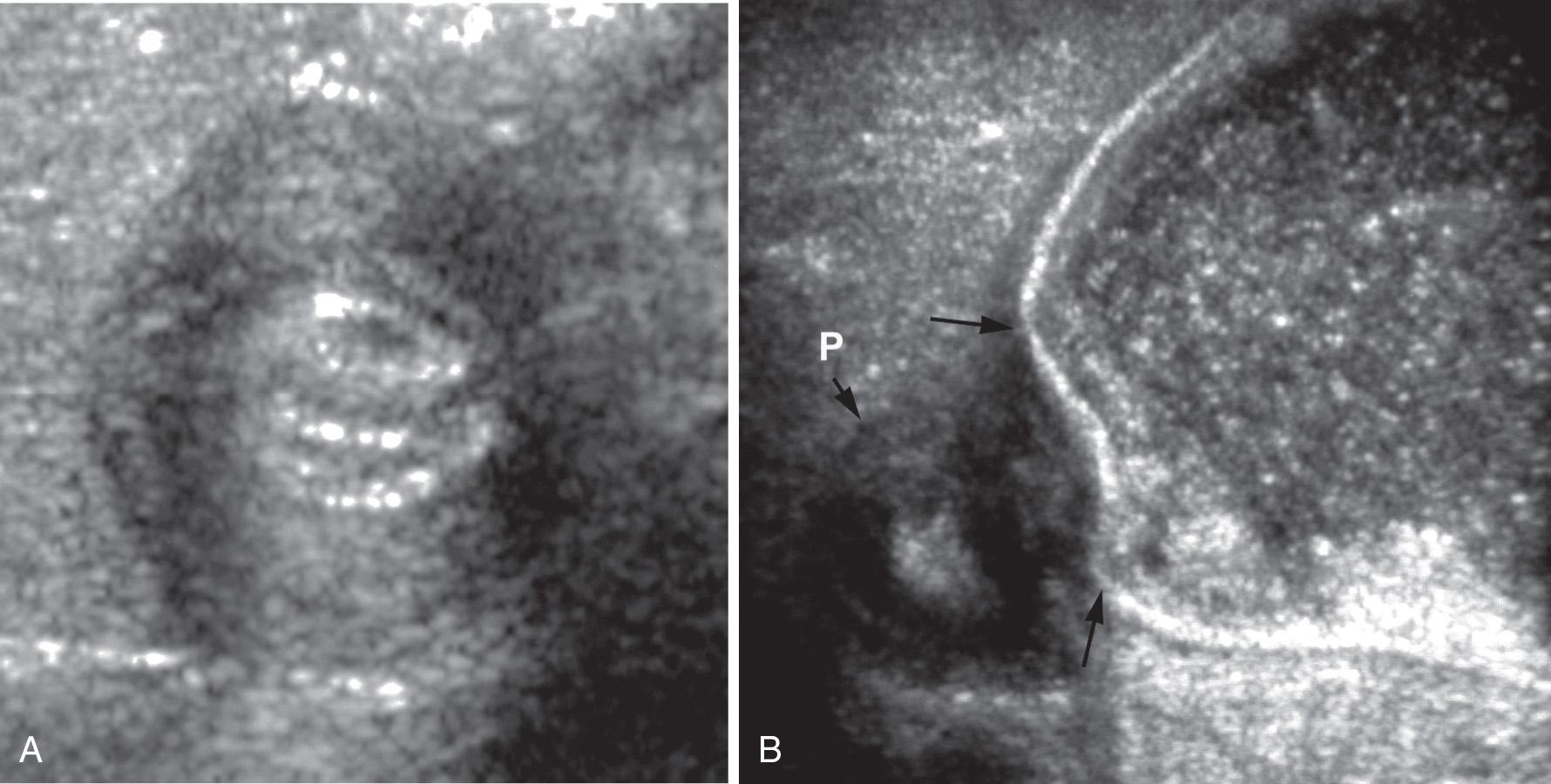
Perhaps the most common pitfall in the sonographic diagnosis of pyloric muscle hypertrophy is inadequate distention of the gastric antrum with fluid. When the antrum is relatively empty, it remains contracted, and the muscle layer can appear falsely thickened ( Fig. 53.10 ). When administering oral fluids for this study, keeping the infant in a right posterior oblique position helps to ensure that the fluid will fully distend the antrum. Despite these occasional pitfalls, the sonographic diagnosis of pyloric stenosis is generally straightforward.
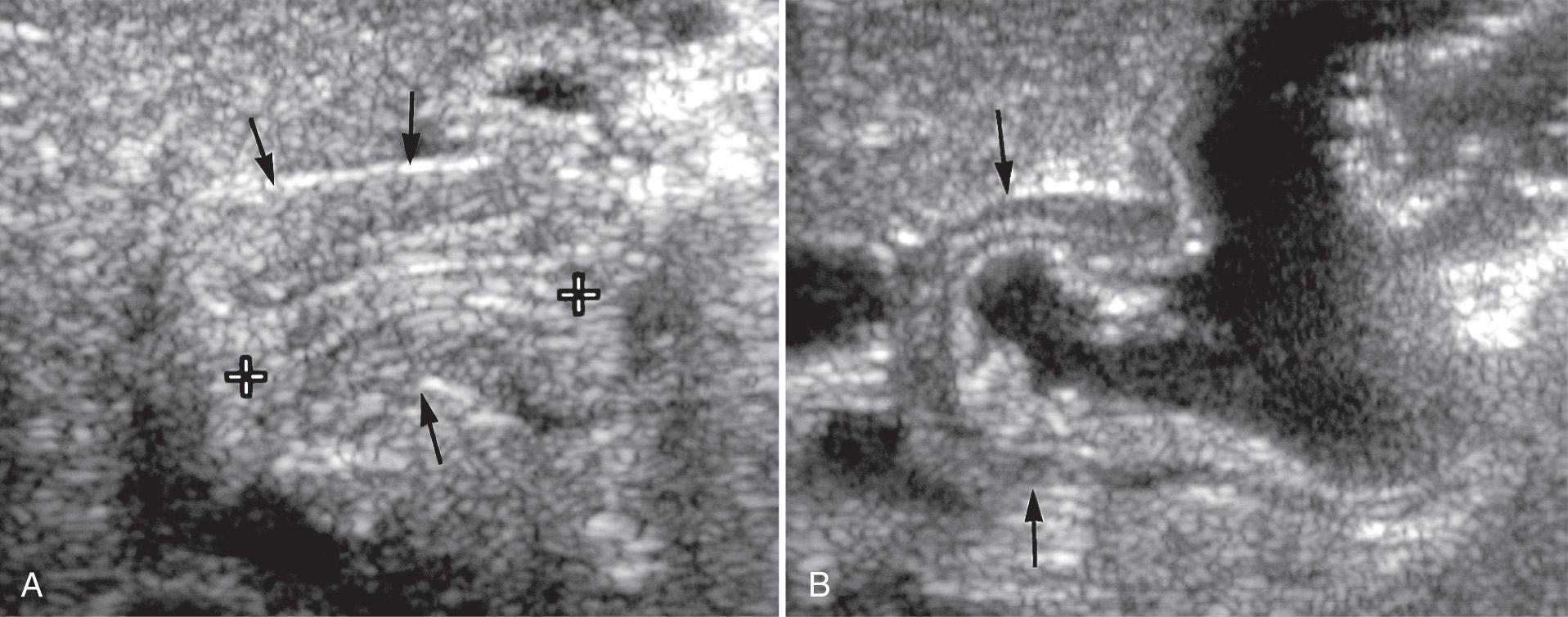
The gastric diaphragm, or antral web, consists of a congenital membrane that extends across the gastric antrum. These diaphragms most often lie less than 2 cm from the pylorus and are therefore usually visible on ultrasound examination. Complete diaphragms are considered one form of gastric atresia, but many diaphragms are incomplete and cause variable degrees of obstruction. On sonography, the web appears as an echogenic band across the distal gastric antrum ( Fig. 53.11 ). Care must be taken to image such webs in the true midlongitudinal plane because if an incomplete diaphragm is imaged at its periphery, a complete diaphragm may be erroneously suggested.
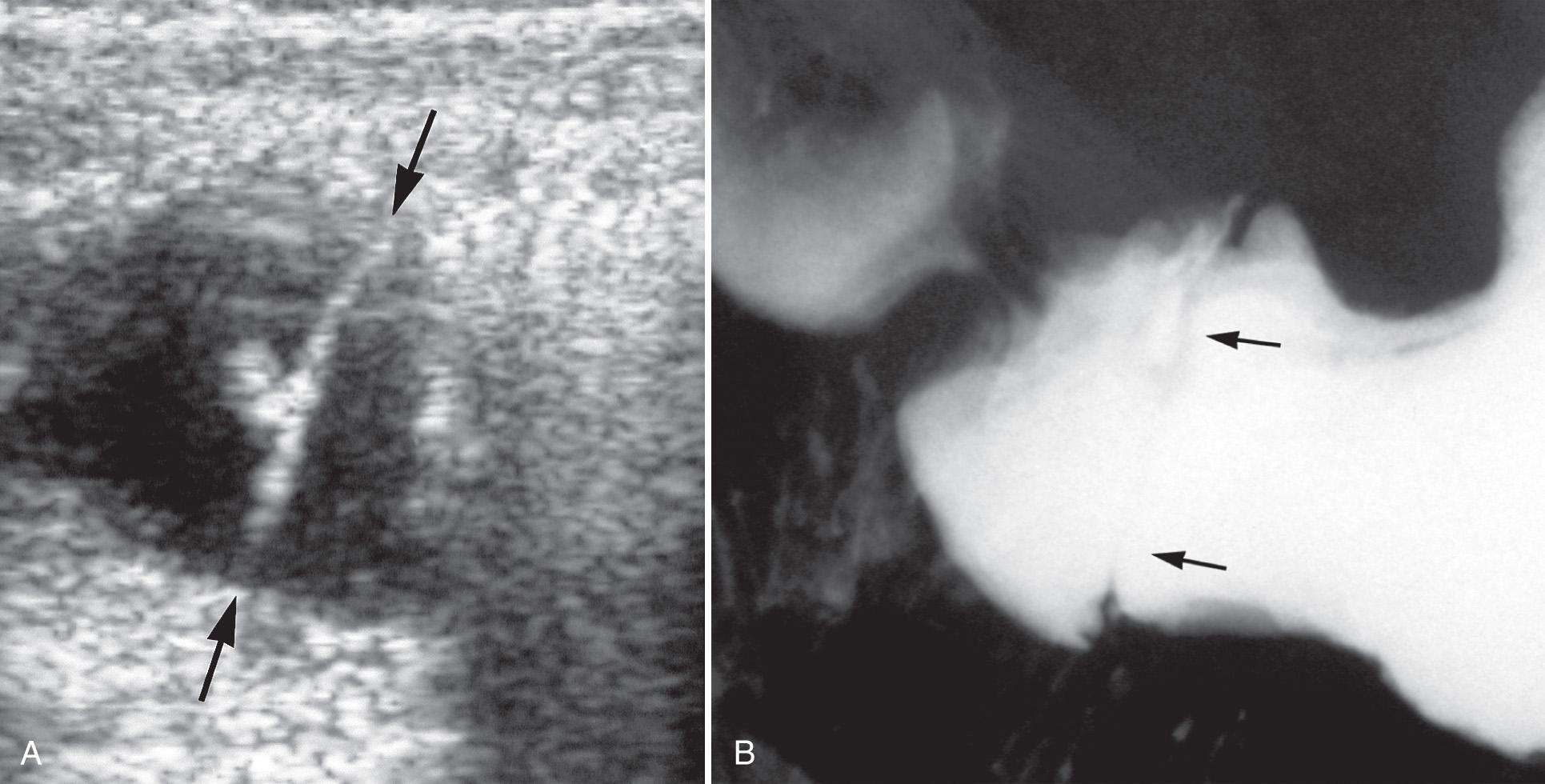
Become a Clinical Tree membership for Full access and enjoy Unlimited articles
If you are a member. Log in here